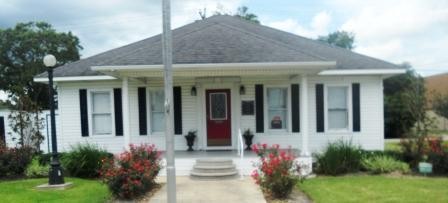Bridge City Chamber of Commerce and Historical Museum
Introduction
Text-to-speech Audio
Images
This small museum shares space with the town's Chamber of Commerce and is located in the former Prairie View Teacherage.

Backstory and Context
Text-to-speech Audio
Present-day Bridge City was first a part Jefferson County during the years of 1836 to 1846 on the account that Orange County was not yet existent. Due to the geographical boundaries of water, the land not yet incorporated by any entity, became a popular frontier for farming pioneers, as well as a notorious hide-out for outlaws. Additionally, according to the Historical Society, "[t]hose trying to stay ahead of the Mexican Army stopped to wait for the all clear signal and just stayed."
Settlers mainly raised meat, but some also farmed cotton, produce, and sugar cane. Additionally, "[s]ome settlers hunted alligators and muskrat." In 1852, the county in which present-day Bridge City is a part of, Orange County, was established, so the community was separated from Jefferson and it became known as Orange, which could only be visited by way of the water that surrounded it.
Rice production became staple of the area thanks to the construction of a canal built by Cow Bayou Canal Company in 1901. One of the first businesses to have gas pumps in the area was Bailey's Fish Camp which opened in 1921 and was located right where the Dryden Ferry brought commuters across the Neches River. It was housed in a one-story building and in addition to a fish camp, the business sold food and drinks. A second floor for the purpose of a dance hall was added in 1933.
In 1940, the tallest bridge in the south--today it is known as Rainbow Bridge--was completed and aided in the growth of Prairie View. In the 1940s, with the increase in traffic because of the bridge, Praire View started to resemble a town; the area featured a horse race track, multiple grocery stores, two dairies, and gas stations. According to the Historical Society, "[t]he first post office was completed in 1946, and by 1952 the estimated population was 3,000. The channelization of Cow Bayou, the completion of the private electric plant in 1962, and the presence of nearby oilfields and petrochemical plants aided industrial growth."
In the 1941, the Prairie View School District and the Winfree School District joined together and was called the Bridge City Consolidated School District as suggested by a group of ladies at a quilting bee. In 1959, the Bridge City Chamber of Commerce formed and touted the town's new slogan:“The Home of the Friendly People on the Grow”. Community members resisted incorporation in 1960, but another attempt by the Orange County Commissioners in June of 1970 proved to be successful.
